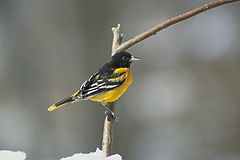- New World oriole
-
"Icterus" redirects here. For the medical condition, see jaundice.
New World orioles 
Baltimore Oriole, Icterus galbula Scientific classification Kingdom: Animalia Phylum: Chordata Class: Aves Order: Passeriformes Family: Icteridae Genus: Icterus
Brisson, 1760Species 25-30 species, see text
New World orioles, comprising the genus Icterus, are a group of birds in the blackbird family. They are not related to Old World orioles which are in the family Oriolidae, but are strikingly similar in size, diet, behaviour and in their strongly contrasting plumage, and are a good example of convergent evolution. Almost inevitably, the two took the same vernacular name.
The males are typically black and yellow or orange, with white markings; the plumage of females and immature birds is duller. These birds go through one moult in a year. They are generally slender with long tails and a pointed bill. They mainly eat insects, often also nectar and fruit. The nest is a woven, elongated pouch. Several species are easy to attract to birdtables by the provision of cut oranges and grape jelly. Species nesting in areas with cold winters (including most of the United States) are strongly migratory, while subtropical and tropical species are more sedentary.
The name "oriole" was first recorded (in the Latin form oriolus) by Albertus Magnus in about 1250, and was stated by him to be onomatopoeic, from the song of the European Golden Oriole.
The genus name Icterus as used by classical authors, referred to a bird with yellow or green plumage. In modern times this has been identified as the golden oriole. Brisson re-applied the name to the New World birds because of their similarity in appearance.[1]
Provisional species list
This species list is provisional. The exact delimitation of several taxa is unclear, and hybridization seems to be a significant confounding factor, for example in the Baltimore and Bullock's Oriole:
- Epaulet Oriole, Icterus cayanensis
- Moriche Oriole, Icterus cayanensis chrysocephalus - recently merged into I. cayanensis
- Yellow-backed Oriole, Icterus chrysater
- Yellow Oriole, Icterus nigrogularis
- Jamaican Oriole, Icterus leucopteryx
- Grand Cayman Oriole, Icterus leucopteryx bairdi - extinct (mid-20th century)
- Orange Oriole, Icterus auratus
- Yellow-tailed Oriole, Icterus mesomelas
- Orange-crowned Oriole, Icterus auricapillus
- White-edged Oriole, Icterus graceannae
- Spot-breasted Oriole, Icterus pectoralis
- Altamira Oriole, Icterus gularis
 Streak-backed Oriole, Icterus pustulatus
Streak-backed Oriole, Icterus pustulatus
- Streak-backed Oriole, Icterus pustulatus
- Bullock's Oriole, Icterus bullockii
- Hooded Oriole, Icterus cucullatus
- (Venezuelan) Troupial, Icterus icterus
- Campo Troupial, Icterus (i.) jamacaii
- Orange-backed Troupial, Icterus (i./j.) croconotus
- Baltimore Oriole, Icterus galbula
- Black-backed Oriole, Icterus abeillei
- Orchard Oriole, Icterus spurius
- Fuertes's Oriole, Icterus (spurius) fuertesi
- Black-cowled Oriole, Icterus prosthemelas
- Bahama Oriole, Icterus northropi
- Cuban Oriole, Icterus melanopsis
- Hispaniolan Oriole, Icterus dominicensis
- Puerto Rican Oriole, Icterus portoricensis
- Black-vented Oriole, Icterus wagleri
- St. Lucia Oriole, Icterus laudabilis
- Martinique Oriole, Icterus bonana
- Montserrat Oriole, Icterus oberi
- Audubon's Oriole, Icterus graduacauda
- Bar-winged Oriole, Icterus maculialatus
- Scott's Oriole, Icterus parisorum
References
- ^
 Newton, Alfred (1911). "Icterus". In Chisholm, Hugh. Encyclopædia Britannica (11th ed.). Cambridge University Press.
Newton, Alfred (1911). "Icterus". In Chisholm, Hugh. Encyclopædia Britannica (11th ed.). Cambridge University Press.
External links
- New World oriole videos, photos and sounds on the Internet Bird Collection
Categories:- Icterus
- Orioles
- Epaulet Oriole, Icterus cayanensis
Wikimedia Foundation. 2010.
